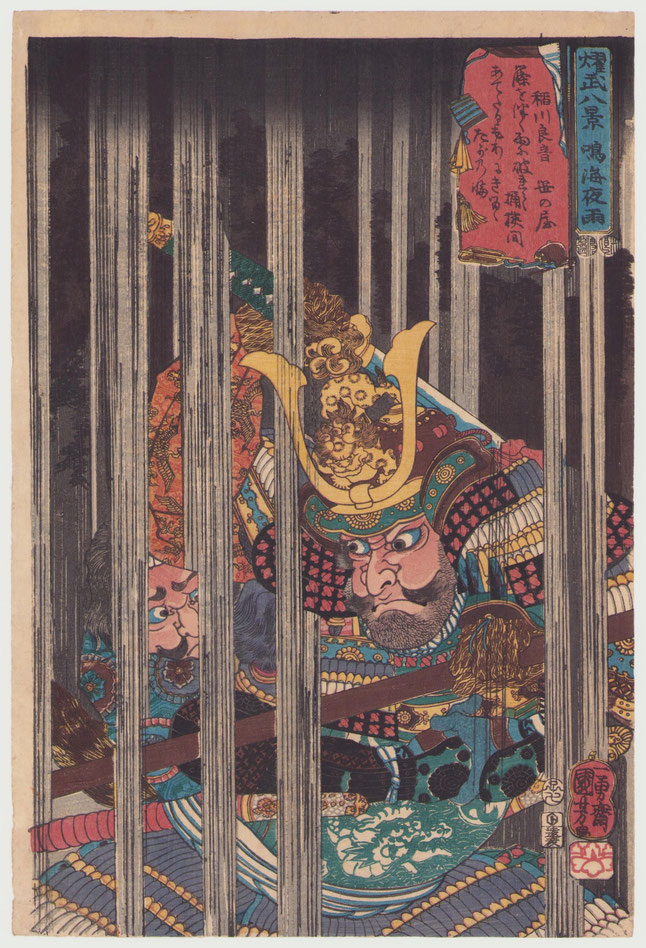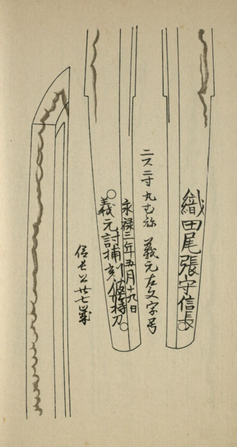歌川国芳 (一勇斎国芳画 芳桐印) 「燿武八景」 鳴海夜雨 稲川良音 「笹の屋 篠をつく雨に破れて桶狭間あてたる毛利に切るゝたが乃海」 嘉永5年(1852)作
Utagawa KUNIYOSHI (signed Ichiyûsai Kuniyoshi Ga with Yoshikiri seal), Night rain at Narumi, Inagawa Yoshioto
from the series “Eight Views of the Military Brilliance” (Yôbu Hakkei), 1852
Robinson S76.7
Utagawa KUNIYOSHI (signé Ichiyûsai Kuniyoshi Ga avec le sceau Yoshikiri), Pluie nocturne à Narumi, Inagawa Yoshioto,
de la série “Huit vues de l'éclat militaire” (Yôbu Hakkei), 1852
Robinson S76.7

桶狭間の戦い(1560年)で織田信長に敗れた今川義元の最期の様子を描いた作品。
国芳は「燿武八景」という揃物を1836年、そして1852年の2回にわたり、中国の山水画の伝統的な画題「瀟湘八景」にちなんで描きました。桶狭間の戦いにおける今川義元の最期をテーマにした「鳴海夜雨」は後者の作品で、物寂しく降る夜の雨の風景を表す瀟湘夜雨の画題に沿ってこの印象的な作品を製作しました。版元 遠州屋彦兵衛
Imagawa Yoshimoto being defeated in a downpour of rain at the battle of Okehazama (1560).
Kuniyoshi created two series of eight prints called "Eight Views of the Military Brilliance" (Yôbu Hakkei) in 1836 and 1852, which were inspired by the traditional theme of Chinese landscape painting, "The Eight Views of Xiaoxiang". The theme of Imagawa Yoshimoto's final moments in the Battle of Okehazama, "Narumi Night Rain", is from the latter series. This impressive artwork follows the theme of "The rain at night on the Xiaoxiang", which depicts a lonesome night-time rainy landscape. Published by Enshû-ya Hikobei.
Imagawa Yoshimoto vaincu sous une pluie battante à la bataille d'Okehazama (1560).
Kuniyoshi a créé deux séries de huit estampes appelées « Huit vues de l'éclat militaire » (Yôbu Hakkei) en 1836 et 1852, inspirées du thème traditionnel de la peinture paysagère chinoise, « Les huit vues de Xiaoxiang ». Le thème des derniers instants d'Imagawa Yoshimoto dans la bataille d'Okehazama, "Pluie nocturne à Narumi", est issu de cette dernière série. Cette œuvre impressionnante suit le thème de « la pluie la nuit sur le Xiaoxiang », qui représente un paysage pluvieux nocturne solitaire. Publiée par Enshû-ya Hikobei.
義元は討ち取られた時に左文字の太刀と郷義弘の刀を帯びていたと伝えられています。
「義元の網代の輿を信長見て、敵の旗本疑なし、とて追立て戦はれしかば、義元も返し合わせて戦はれしを、服部小平太槍つけ、毛利新助其の首を取りたりけり。左文字の太刀松倉郷の刀分捕りにすといへり。」常山紀談より
その太刀は後に織田信長のために磨り上げられて、豊臣秀吉そして徳川家康の手に渡り、現在は京都の建勲神社の所蔵となっています。
It is said that when he was defeated, Imagawa Yoshimoto had a tachi made by Samonji and a katana made by Gô Yoshihiro. The tachi was then passed down to Oda Nobunaga, Toyotomi Hideyoshi and Hideyori, then to Tokugawa Ieyasu and is presently in the collection of the Takeisao Shrine of Kyoto. It has been shortened for Nobunaga into a katana size and is now called Yoshimoto Samonji or Oda Samonji.
On raconte que lors de sa défaite, Imagawa Yoshimoto portait un tachi forgé par Samonji et un katana forgé par Gô Yoshihiro. Le tachi fut ensuite transmis à Oda Nobunaga, Toyotomi Hideyoshi et Hideyori, puis à Tokugawa Ieyasu et il fait actuellement partie de la collection du sanctuaire Takeisao de Kyoto. Il a été raccourci pour Nobunaga à la taille d'un katana et est surnommé Yoshimoto Samonji ou Oda Samonji.

約 25,1 x 37,3 cm(マージン含む)
状態
摺 優
保存 優
極少穴、極少シワ、
薄い中折れ(横)
裏面上部に小さな剝がし跡2か所
補修なし
裏打ちなし
About 25,1 x 37,3 cm (including margins)
Condition :
Impression: very good
State of conservation: very good
A few very small holes, very light wrinkles, light horizontal fold,
Remains of peeled off paper (both upper corners of the back of the print), not restored,
Not backed
Environ 25,1 x 37,3 cm (marges comprises)
Condition :
Impression : très bonne
État de conservation : très bon
Quelques très petits trous, très légères froissures, léger pli horizontal,
Restes de papier décollé (aux deux coins supérieurs du verso),
Non restaurée, pas de doublage du papier
SOLD

